Table of Contents
Advances in porousizing catalysts for boosting CO2 electroreduction
DICP | CAS – With the continuous growth of global energy demand and escalating environmental issues, CO2 emissions have surged dramatically, reaching up to 54 billion tons annually, capturing worldwide attention.
Converting CO2 into high-value chemicals not only helps mitigate global climate change but also promotes the development of the carbon cycle and green chemistry. Electrochemical CO2 reduction reactions (eCO2RR) offer an effective pathway for this conversion, and porous materials, with their unique physicochemical properties, have demonstrated tremendous potential in these reactions.
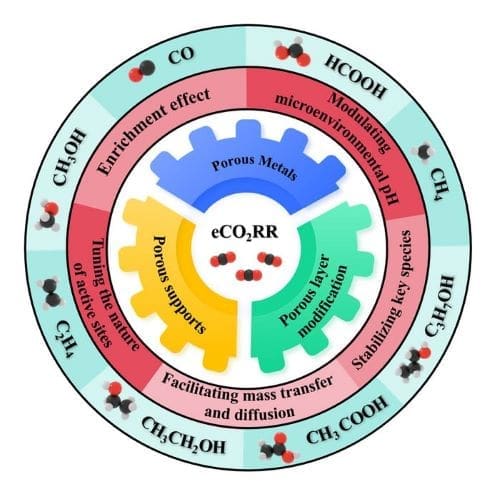
Published in the Chinese Journal of Catalysis, the review by Zhiyong Tang and collaborators at the National Center for Nanoscience and Technology delves into the role of porous catalysts in enhancing CO2 electroreduction.
The research team first introduced the synthesis techniques of porous materials, including template methods and template-free methods, which can precisely control the size, shape, and distribution of porous structures. They then summarized the design strategies for combining porous materials with eCO2RR, such as loading catalytic metal single atoms, molecules, and nanoparticles onto porous supports to enhance the exposure of active sites and optimize local reaction conditions.
Additionally, the team explored the reaction mechanisms of eCO2RR, analyzing key reaction intermediates for different target products.
Enrichment Effect: Porous structures can enrich key intermediates, such as *CO, thereby increasing the selectivity of C2+ products. For instance, by adjusting the pore size of porous Cu catalysts, researchers found that a Cu catalyst with a pore size of 20 nm achieved an ethylene Faraday efficiency of 85.6% and a constant current density of 368 mA cm−2 in a membrane electrode assembly.
Modulating Microenvironmental pH: The cavity and channel structures of porous materials help create a highly alkaline microenvironment near the catalyst surface, which inhibits the hydrogen evolution reaction and promotes CO2 conversion. For example, La-doped Cu hollow sphere catalysts with porous channel structures achieved a C2+ product Faraday efficiency of 86.2% and a partial current density of −775.8 mA cm−2 in acidic electrolytes.
Stabilizing Key Intermediates: Porous structures can stabiliz active species, , such as Cu+, to enhance the selectivity of C2+ products. For example, porous Cu2O catalysts maintained the characteristic Raman mode of Cu+ during electrochemical reduction, with Cu+ species content remaining at 32.1% even after 20 minutes of reaction.
Facilitating Mass Transfer and Diffusion: Porous materials can regulate mass transfer processes, improving reaction rates. For instance, a porous Cu catalytic layer prepared by co-sputtering deposition of Cu and Al, followed by dealloying, promoted gas transmission at high current densities, achieving a C2H4 partial current density of 420 mA cm−2 at a low cell voltage.
Tuning the Nature of Active Sites: Porous nanomaterials, as carriers for metal active centers, can regulate the properties of active sites, thus enhancing the performance of eCO2RR. For example, Ag single atoms anchored on porous concave N-doped carbon achieved a CO Faraday efficiency of 95% at −0.37 V vs. RHE.
This review provides a systematic summary and in-depth insights into the application of porous catalysts in eCO2RR, identifying current challenges such as the precise fabrication of porous structures, understanding structure-performance relationships, and the feasibility of practical applications.
Future research directions include achieving controllable synthesis of porous catalysts, exploring the multiscale effects of porous structures, optimizing catalyst design using theoretical calculations and machine learning, combining emerging characterization techniques to explore reaction mechanisms, and promoting the industrial application of eCO2RR technology, with a focus on cost, catalytic performance, and product value for economic feasibility and environmental sustainability.
Journal Reference:
Xiaoyu You, Caoyu Yang, Xinwei Li, Zhiyong Tang, ‘Porousizing catalysts for boosting CO2 electroreducation’, Chinese Journal of Catalysis 67, 4-20 (2024). DOI: 10.1016/S1872-2067(24)60147-6
Article Source:
Press Release/Material by Dalian Institute of Chemical Physics (DICP) | Chinese Academy Sciences (CAS)
Floods, droughts, then fires: Hydroclimate whiplash is speeding up globally
UCLA – Los Angeles is burning, and accelerating hydroclimate whiplash is the key climate connection.
After years of severe drought, dozens of atmospheric rivers deluged California with record-breaking precipitation in the winter of 2022-23, burying mountain towns in snow, flooding valleys with rain and snow melt, and setting off hundreds of landslides.
Following a second extremely wet winter in southern parts of the state, resulting in abundant grass and brush, 2024 brought a record-hot summer and now a record-dry start to the 2025 rainy season, along with tinder-dry vegetation that has since burned in a series of damaging wildfires.
This is just the most recent example of the kind of “hydroclimate whiplash” – rapid swings between intensely wet and dangerously dry weather – that is increasing worldwide, according to a paper published in Nature Reviews Earth & Environment.
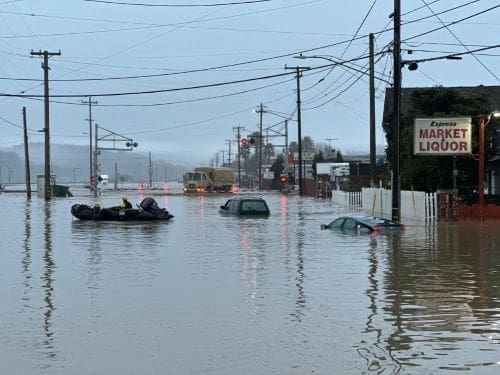
“The evidence shows that hydroclimate whiplash has already increased due to global warming, and further warming will bring about even larger increases,” said lead author Daniel Swain, a climate scientist with UCLA and UC Agriculture and Natural Resources. “This whiplash sequence in California has increased fire risk twofold: first, by greatly increasing the growth of flammable grass and brush in the months leading up to fire season, and then by drying it out to exceptionally high levels with the extreme dryness and warmth that followed.”
Global weather records show hydroclimate whiplash has swelled globally by 31% to 66% since the mid-20th century, the international team of climate researchers found – even more than climate models suggest should have happened.
Climate change means the rate of increase is speeding up.
The same potentially conservative climate models project that the whiplash will more than double if global temperatures rise 3 degrees Celsius above pre-industrial levels. The world is already poised to blast past the Paris Agreement’s targeted limit of 1.5 C. The researchers synthesized hundreds of previous scientific papers for the review, layering their own analysis on top.
Anthropogenic climate change is the culprit behind the accelerating whiplash, and a key driver is the “expanding atmospheric sponge” – the growing ability of the atmosphere to evaporate, absorb and release 7% more water for every degree Celsius the planet warms, researchers said.
“The problem is that the sponge grows exponentially, like compound interest in a bank,” Swain said. “The rate of expansion increases with each fraction of a degree of warming.”
The global consequences of hydroclimate whiplash include not only floods and droughts, but the heightened danger of whipsawing between the two, including the bloom-and-burn cycle of overwatered then overdried brush, and landslides on oversaturated hillsides where recent fires removed plants with roots to knit the soil and slurp up rainfall. Every fraction of a degree of warming speeds the growing destructive power of the transitions, Swain said.
Many previous studies of climate whiplash have only considered the precipitation side of the equation, and not the growing evaporative demand. The thirstier atmosphere pulls more water out of plants and soil, exacerbating drought conditions beyond simple lack of rainfall.
“The expanding atmospheric sponge effect may offer a unifying explanation for some of the most visible, visceral impacts of climate change that recently seem to have accelerated,” Swain said. “The planet is warming at an essentially linear pace, but in the last 5 or 10 years there has been much discussion around accelerating climate impacts. This increase in hydroclimate whiplash, via the exponentially expanding atmospheric sponge, offers a potentially compelling explanation.”
That acceleration, and the anticipated increase in boom-and-bust water cycles, has important implications for water management.
“We can’t look at just extreme rainfall or extreme droughts alone, because we have to safely manage these increasingly enormous influxes of water, while also preparing for progressively drier interludes,” Swain said. “That’s why ‘co-management’ is an important paradigm. It leads you to more holistic conclusions about which interventions and solutions are most appropriate, compared to considering drought and flood risk in isolation.”
In many regions, traditional management designs include shunting flood waters to flow quickly into the ocean, or slower solutions like allowing rain to percolate into the water table. However, taken alone, each option leaves cities vulnerable to the other side of climate whiplash, the researchers noted.
“Hydroclimate in California is reliably unreliable,” said co-author John Abatzoglou, a UC Merced climate scientist. “However, swings like we saw a couple years ago, going from one of the driest three-year periods in a century to the once-in-a-lifetime spring 2023 snowpack, both tested our water-infrastructure systems and furthered conversations about floodwater management to ensure future water security in an increasingly variable hydroclimate.”
Hydroclimate whiplash is projected to increase most across northern Africa, the Middle East, South Asia, northern Eurasia, the tropical Pacific and the tropical Atlantic, but most other regions will also feel the shift.
“Increasing hydroclimate whiplash may turn out to be one of the more universal global changes on a warming Earth,” Swain said.
In California this week, although winds are fanning the extreme fires, it’s the whiplash-driven lack of rain that suspended Southern California in fire season.
“There’s not really much evidence that climate change has increased or decreased the magnitude or likelihood of the wind events themselves in Southern California,” Swain said. “But climate change is increasing the overlap between extremely dry vegetation conditions later in the season and the occurrence of these wind events. This, ultimately, is the key climate change connection to Southern California wildfires.”
Under a high warming scenario, California will see an increase in both the wettest and driest years and seasons by later this century.
“The less warming there is, the less of an increase in hydroclimate whiplash we’re going to see,” Swain said. “So anything that would reduce the amount of warming from climate change will directly slow or reduce the increase in whiplash. Yet we are currently still on a path to experience between 2 degrees and 3 degrees Celsius of global warming this century — so substantial further increases in whiplash are likely in our future, and we really need to be accounting for this in risk assessments and adaptation activities.”
The research was supported with funding from The Nature Conservancy of California and the Swiss National Science Foundation.
Journal Reference:
Swain, D.L., Prein, A.F., Abatzoglou, J.T. et al. ‘Hydroclimate volatility on a warming Earth’, Nature Reviews Earth & Environment 6, 35–50 (2025). DOI: 10.1038/s43017-024-00624-z
Article Source:
Press Release/Material by Alison Hewitt | University of California – Los Angeles
Researchers use lab data to rewrite equation for deformation, flow of watery glacier ice
AMES, Iowa | Iowa State University – Neal Iverson started with two lessons in ice physics when asked to describe a research paper about glacier ice flow that has just been published by the journal Science.
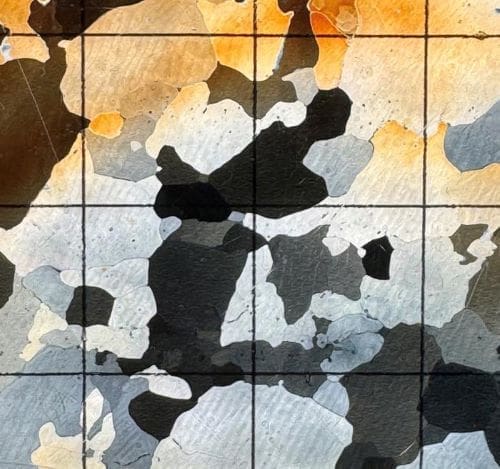
First, said the distinguished professor emeritus of Iowa State University’s Department of the Earth, Atmosphere, and Climate, there are different types of ice within glaciers. Parts of glaciers are at their pressure-melting temperature and are soft and watery.
That temperate ice is like an ice cube left on a kitchen counter, with meltwater pooling between the ice and the countertop, he said. Temperate ice has been difficult to study and characterize.
Second, other parts of glaciers have cold, hard ice, like an ice cube still in the freezer. This is the kind of ice that has typically been studied and used as the basis of glacier flow models and forecasts.
The new research paper, ‘Linear-viscous flow of temperate ice‘, deals with the former, said Iverson, a paper co-author and project supervisor. (Research team: Iowa State University – Neal Iverson, Collin Schohn (now of the BBJ Group) and Jacob Fowler (now at the University of Pennsylvania); University of Wisconsin-Madison – Lucas Zoet, Natasha Morgan-Witts)
The paper describes lab experiments and the resulting data that suggest a standard value within the “empirical foundation of glacier flow modeling” – an equation known as Glen’s flow law, named after the late John W. Glen, a British ice physicist – should be changed for temperate ice.
The new value when used in the flow law “will tend to predict increases in flow velocity that are much smaller in response to increased stresses caused by ice sheet shrinkage as the climate warms,” Iverson said. That would mean models will show less glacier flow into oceans and project less sea-level rise.
An acute need to account for warm glacier ice
Open the walk-in freezer in Iverson’s campus lab and you’re looking at a 9-foot-tall ring-shear device that’s been simulating glacial forces and movement since 2009. It was built with a $530,000 grant from the National Science Foundation. The current study was also supported by NSF grants.
At the center of the device is a ring of ice about 3 feet across and 7 inches thick. Below the ring is a hydraulic press that can put as much as 100 tons of force on the ice and simulate the weight of a glacier 800 feet thick. The ice ring is surrounded by a tub of circulating fluid that regulates the ice temperature to the nearest hundredth of a degree. Electric motors attached to a plate with grippers above the ice ring can rotate the ice at speeds of 1 to 10,000 feet per year.
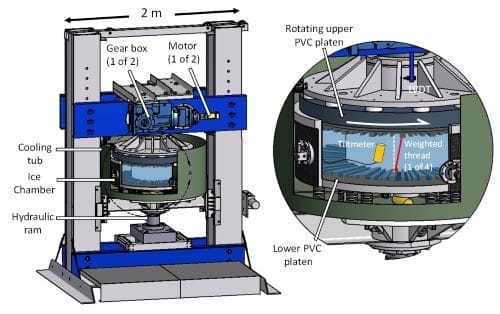
For this project, researchers modified the device by adding another gripper to the bottom of the ice ring so that rotation of the upper gripper shears the underlying ice.
Collin Schohn, a former master’s degree student at Iowa State who’s now a geologist with the BBJ Group based in Chicago and is the first author of the group’s latest research paper, ran a series of six experiments using the modified device, each experiment lasting about six weeks. The experiments included measurements of the ice’s liquid water content, something that hadn’t been done in these kinds of experiments since the 1970s.
“These experiments involved deforming the ice at its melting temperatures and at various stresses,” Schohn said.
Iverson likened the experiments to grabbing a bagel at the top and the bottom, then twisting the two halves to smear the cream cheese in the middle.
The experimental data showed that ice deformed at a speed that was linearly proportional to the stress, Iverson said. Traditional thinking would have researchers expecting ice to soften with increasing stress, so increments in stress would cause increasingly large increments in speed.
Why does all this matter?
Ice is temperate near the bottoms and edges of the fastest flowing parts of ice sheets and in fast-flowing mountain glaciers, both of which shed ice into oceans and influence sea level. “The need to model and forecast accurately the flow of warm glacier ice is, therefore, acute,” the authors wrote.
Resetting n to 1.0
Glen’s flow law is written as: ε ̇= Aτn.
The equation relates the stress on ice, τ, to its rate of deformation, ε ̇, where A is a constant for a particular ice temperature. Results of the new experiments show that the value of the stress exponent, n, is 1.0 rather than the usually assigned value of 3 or 4.
The authors wrote, “For generations, based on Glen’s original experiments and many subsequent experiments mostly on cold ice (-2 degrees C and colder), the value of the stress exponent n in models has been taken to be 3.0.” (They also wrote that other studies of the “cold ice of ice sheets” have placed n higher yet, at 4.0.)
That was, in part, “because experiments with ice at the pressure melting temperature are a challenge,” said Lucas Zoet, a paper co-author, a former postdoctoral research associate at Iowa State and the Dean L. Morgridge Associate Professor of geoscience at the University of Wisconsin-Madison. Zoet, a co-supervisor of the project, has built a slightly smaller version of the ring-shear device with transparent walls for his laboratory.
But data from the large-scale, shear-deformation experiments in Iverson’s lab raised questions about the assigned value for n. Temperate ice is linear-viscous (n = 1.0) “over common ranges of liquid water content and stress expected near glacier beds and in ice stream margins,” the authors wrote.
They proposed that the cause is melting and refreezing along the boundaries of individual, millimeter-to-centimeter scale grains of ice, which should occur at rates linearly proportional to the stress.
These new data allow modelers “to base their ice sheet models on physical relationships demonstrated in the laboratory,” Zoet said. “Improving that understanding improves the accuracy of predictions.”
It took some perseverance to get the data supporting the new value of n.
“We had been batting this project around for years,” Schohn said. “It was really hard to get this to work.”
In the end, Iverson said, “considering all the failures and development, this was about a 10-year process.”
A long process, the researchers said, that’s essential for more accurate models of temperate glacier ice and better predictions of glacier flow and sea-level rise.
Journal Reference:
Collin M. Schohn et al. ‘Linear-viscous flow of temperate ice’, Science 387, 182-185 (2025). DOI: 10.1126/science.adp7708
Article Source:
Press Release/Material by Iowa State University
Kangaroos kept a broad diet through late Pleistocene climate changes
AAAS – Samuel Arman and colleagues’ close examination of tooth microwear among living and extinct kangaroo species suggests that most of the species living in Australia during the Late Pleistocene had a broad, generalist diet rather than being specialized grazers.
This broad diet likely allowed them to survive the glacial-interglacial cycles that drove fluctuations in vegetation on the continent. The findings add more evidence to the idea that human hunting, rather than failure to adapt to climate changes, was behind the late megafaunal extinction in Australia.
By 40,000 years ago, Australia had lost 90% of its large species, more than half of them kangaroos. To determine whether kangaroo species were able to adapt to climate-driven vegetation changes at the time, Arman et al. examined 2650 enamel scans from 937 individual specimens to characterize the diets of a diverse Pleistocene kangaroo fossil assemblage. Chewing food with different material properties leaves distinctive microscopic wear marks on tooth enamel that can then be associated with different diets.
The researchers found no statistically significant differences in microwear among most species in the fossil assemblage, and the microwear itself suggested the species did not pursue specialized diets.
Journal Reference:
Samuel D. Arman et al. ‘Dietary breadth in kangaroos facilitated resilience to Quaternary climatic variations’, Science 387, 167-171 (2025). DOI: 10.1126/science.adq4340
Article Source:
Press Release/Material by Becky Ham | American Association for the Advancement of Science (AAAS)
Storing carbon in buildings could help address climate change
UC Davis – Construction materials such as concrete and plastic have the potential to lock away billions of tons of carbon dioxide, according to a new study by civil engineers and earth systems scientists at the University of California, Davis and Stanford University.
The study, published in Science, shows that combined with steps to decarbonize the economy, storing CO2 in buildings could help the world achieve goals for reducing greenhouse gas emissions.
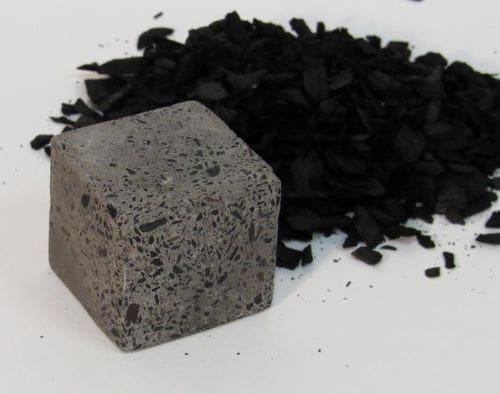
“The potential is pretty large,” said Elisabeth Van Roijen, who led the study as a graduate student at UC Davis.
The goal of carbon sequestration is to take carbon dioxide, either from where it is being produced or from the atmosphere, convert it into a stable form and store it away from the atmosphere where it cannot contribute to climate change. Proposed schemes have involved, for example, injecting carbon underground or storing it in the deep ocean. These approaches pose both practical challenges and environmental risks.
“What if, instead, we can leverage materials that we already produce in large quantities to store carbon?” Van Roijen said.
Working with Sabbie Miller, associate professor of civil and environmental engineering at UC Davis, and Steve Davis at Stanford University, Van Roijen calculated the potential to store carbon in a wide range of common building materials including concrete (cement and aggregates), asphalt, plastics, wood and brick.
More than 30 billion tons of conventional versions of these materials are produced worldwide every year.
Concrete potential
The carbon-storing approaches studied included adding biochar (made by heating waste biomass) into concrete; using artificial rocks that can be loaded with carbon as concrete and asphalt pavement aggregate; plastics and asphalt binders based on biomass rather than fossil petroleum sources; and including biomass fiber into bricks. These technologies are at different stages of readiness, with some still being investigated at a lab or pilot scale and others already available for adoption.
Researchers found that while bio-based plastics could take up the largest amount of carbon by weight, by far the largest potential for carbon storage is in using carbonated aggregates to make concrete. That’s because concrete is by far the world’s most popular building material: Over 20 billion tons are produced every year.
“If feasible, a little bit of storage in concrete could go a long way,” Miller said. The team calculated that if 10% of the world’s concrete aggregate production were carbonateable, it could absorb a gigaton of CO2.
The feedstocks for these new processes for making building materials are mostly low-value waste materials such as biomass, Van Roijen said. Implementing these new processes would enhance their value, creating economic development and promoting a circular economy, she said.
Some technology development is needed, particularly in cases where material performance and net-storage potential of individual manufacturing methods must be validated. However, many of these technologies are just waiting to be adopted, Miller said.
Van Roijen is now a researcher at the U.S. Department of Energy National Renewable Energy Laboratory. The work was supported by Miller’s CAREER grant from the National Science Foundation.
Journal Reference:
Elisabeth Van Roijen et al. ‘Building materials could store more than 16 billion tonnes of CO2 annually’, Science 387, 176-182 (2025). DOI: 10.1126/science.adq8594
Article Source:
Press Release/Material by Andy Fell | University of California – Davis (UC Davis)
Two-in-one root armor protects plants from environmental stressors and fights climate change
Salk Institute – Plants may burrow into the ground and stretch toward the sun, but they’re ultimately stuck where they sprout — at the mercy of environmental threats like temperature, drought, and microbial infection.
To compensate for their inability to up and move when danger strikes, many plants have evolved ways to protect themselves by altering their physiology, such as building armor around parts of their body and roots called the periderm. However, since many plant biologists who study tissue development look at young plants, later-in-life periderm development has remained relatively unexplored.
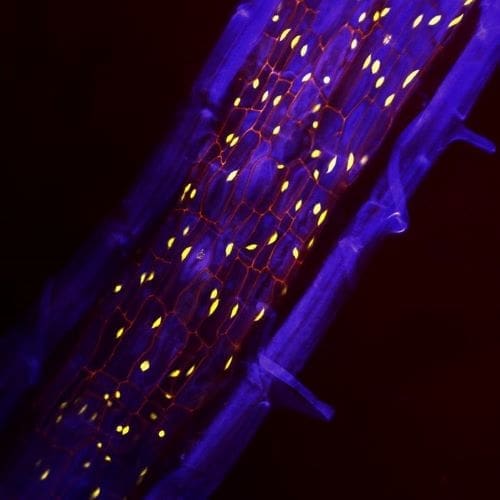
Salk Institute
Salk Institute researchers have debuted the first comprehensive gene expression atlas of the plant periderm at the single-cell level. The atlas provides new information about the different kinds of cells that make up the periderm and which specific genes and biological processes control their development. This includes important insights into phellem cells, which are rich in suberin — a molecule that helps capture and store excess carbon from the atmosphere for a long time.
Scientists can now use this information to stimulate growth of the protective periderm in plants facing environmental stress due to climate change. They can also potentially boost phellem cell growth genes to produce plants with enhanced carbon-capturing and storing abilities — a central goal of Salk’s Harnessing Plants Initiative.
The findings were published in Developmental Cell.
“Plants play a crucial role in capturing carbon from the atmosphere and storing it in the soil,” says Professor Wolfgang Busch, senior author of the study, director of the Harnessing Plants Initiative, and Hess Chair in Plant Science at Salk. “The protective outer layer of plant roots, called the periderm, is made up of many cells that can store carbon in a form that will be very durable. By creating a detailed map of how these root cells form and mature, we can better understand and potentially encourage this process to help plants hold on to more carbon in highly durable forms. In doing so, we can create more resilient plants with hardier roots that also help us fight climate change.”
When a plant first takes root, it dedicates itself to primary growth, focusing on the length of new roots. With maturity comes secondary growth, shifting the focus to thickening existing roots and creating periderm armor. This protective periderm contains phellem, phellogen, and phelloderm cells, each with distinct responsibilities and genetic profiles that had yet to be fully described in previous studies.
Of these various periderm cells, the team was most interested in phellem cells because of their high suberin content. Suberin is central to Salk’s Harnessing Plants Initiative, in which scientists optimize plants to serve as a natural and sustainable method of carbon sequestration.
Unfortunately, carbon stored in leaves and stems can degrade quickly and become easily re-released into the atmosphere. In contrast, the suberin in a plant’s roots can hold carbon deep in the soil for long stretches of time. Suberin has also been shown to make plants more resistant to root rot, indicating that it serves a protective purpose in addition to carbon storage.
Previous periderm studies consisted of bulk analyses that, despite providing valuable insights, were not able to capture cell type specificity. To correct this, the Salk team applied modern single-cell sequencing techniques that could capture the distinct genetic profiles of each periderm cell type. They also tracked how gene expression changed as each cell type developed in the roots of Arabidopsis thaliana — a flowering weed in the mustard family commonly used in plant research.

“Collecting this level of detail in mature plants across time has never been achieved before,” says first author Charlotte Miller, a research scientist in Busch’s lab. “Other studies grind up entire roots and study them in bulk, but single-cell analysis allowed us to understand the genetic development of each individual cell type in the periderm. This means we can be far more precise and efficient in engineering robust, resilient, climate change-fighting plants.”
The researchers’ single-cell time-course sequencing revealed that phellem cell development can be dissected into multiple genetically distinct but interconnected phases. This stepwise development was marked by key genes like MYB67, which the team discovered was playing a large role in regulating the development process.
By piecing together the cells’ genetic profiles at different periods in their development, the team hopes to eventually determine a gene or set of genes that could be used to encourage plants to make more phellem cells, contain more suberin, and capture more durable carbon.
The periderm atlas also yielded important insights into other non-phellem cells. This data will help clarify the transitional stages in periderm development, like how phellogen cells give rise to phellem cells. Miller is particularly excited to continue studying these phellogen cells, noting that their stem-cell-like ability to differentiate into other cell types so late into the plant’s development is surprising.
As for Busch, he looks forward to seeing how suberin-containing cells plug up holes made by new lateral root growth — a destructive process where new roots break through the plants’ skin. These responsive, suberin-rich cells may not be a part of the periderm, but knowing more about the periderm cell types and suberin content may aid in future understanding of this root creation process wherein root systems branch out extensively while avoiding infection.
“Our work not only advances plant science but also opens the door to creating more robust crops and enhancing carbon sequestration through plant roots, providing solutions to both agricultural and climate challenges, which is a key goal of Salk’s Harnessing Plants Initiative,” says Busch.
Other authors include Sean Jarrell-Hurtado, Manisha Haag, Y. Sara Ye, Mathew Simenc, Paloma Alvarez-Maldonado, Sara Behnami, Ling Zhang, Joseph Swift, Ashot Papikian, Jingting Yu, Kelly Colt, Joseph Ecker, Todd Michael, and Julie Law of Salk.
***
The work was supported by the Bezos Earth Fund, Hess Corporation, and TED Audacious Project.
Journal Reference:
Charlotte N. Miller, Sean Jarrell-Hurtado, Manisha V. Haag, Y. Sara Ye, Mathew Simenc, Paloma Alvarez-Maldonado, Sara Behnami, Ling Zhang, Joseph Swift, Ashot Papikian, Jingting Yu, Kelly Colt, Joseph R. Ecker, Todd P. Michael, Julie A. Law, Wolfgang Busch, ‘A single nuclei transcriptome census of the Arabidopsis maturing root identifies that MYB67 controls phellem cell maturation’, Developmental Cell (2025). DOI: 10.1016/j.devcel.2024.12.025
Article Source:
Press Release/Material by The Salk Institute For Biological Studies
Featured image credit: Gerd Altmann | Pixabay




